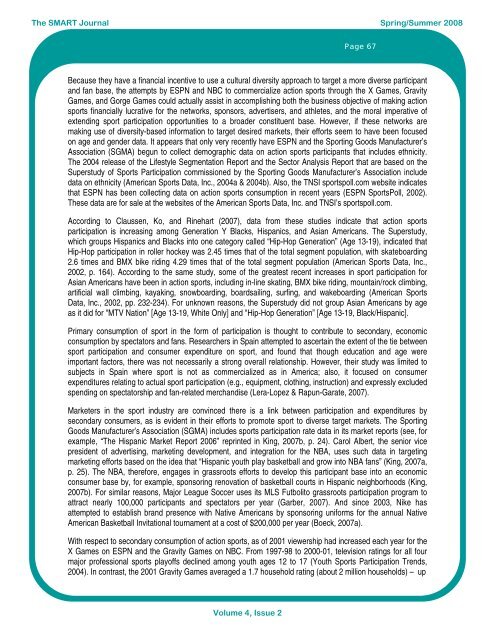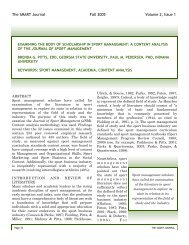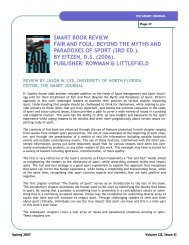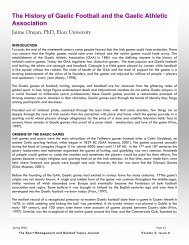Spring/Summer 2008 Volume 4, Issue 2 - The SMART Journal
Spring/Summer 2008 Volume 4, Issue 2 - The SMART Journal
Spring/Summer 2008 Volume 4, Issue 2 - The SMART Journal
You also want an ePaper? Increase the reach of your titles
YUMPU automatically turns print PDFs into web optimized ePapers that Google loves.
<strong>The</strong> <strong>SMART</strong> <strong>Journal</strong> <strong>Spring</strong>/<strong>Summer</strong> <strong>2008</strong><br />
Page 67<br />
Because they have a financial incentive to use a cultural diversity approach to target a more diverse participant<br />
and fan base, the attempts by ESPN and NBC to commercialize action sports through the X Games, Gravity<br />
Games, and Gorge Games could actually assist in accomplishing both the business objective of making action<br />
sports financially lucrative for the networks, sponsors, advertisers, and athletes, and the moral imperative of<br />
extending sport participation opportunities to a broader constituent base. However, if these networks are<br />
making use of diversity-based information to target desired markets, their efforts seem to have been focused<br />
on age and gender data. It appears that only very recently have ESPN and the Sporting Goods Manufacturer’s<br />
Association (SGMA) begun to collect demographic data on action sports participants that includes ethnicity.<br />
<strong>The</strong> 2004 release of the Lifestyle Segmentation Report and the Sector Analysis Report that are based on the<br />
Superstudy of Sports Participation commissioned by the Sporting Goods Manufacturer’s Association include<br />
data on ethnicity (American Sports Data, Inc., 2004a & 2004b). Also, the TNSI sportspoll.com website indicates<br />
that ESPN has been collecting data on action sports consumption in recent years (ESPN SportsPoll, 2002).<br />
<strong>The</strong>se data are for sale at the websites of the American Sports Data, Inc. and TNSI’s sportspoll.com.<br />
According to Claussen, Ko, and Rinehart (2007), data from these studies indicate that action sports<br />
participation is increasing among Generation Y Blacks, Hispanics, and Asian Americans. <strong>The</strong> Superstudy,<br />
which groups Hispanics and Blacks into one category called “Hip-Hop Generation” (Age 13-19), indicated that<br />
Hip-Hop participation in roller hockey was 2.45 times that of the total segment population, with skateboarding<br />
2.6 times and BMX bike riding 4.29 times that of the total segment population (American Sports Data, Inc.,<br />
2002, p. 164). According to the same study, some of the greatest recent increases in sport participation for<br />
Asian Americans have been in action sports, including in-line skating, BMX bike riding, mountain/rock climbing,<br />
artificial wall climbing, kayaking, snowboarding, boardsailing, surfing, and wakeboarding (American Sports<br />
Data, Inc., 2002, pp. 232-234). For unknown reasons, the Superstudy did not group Asian Americans by age<br />
as it did for "MTV Nation” [Age 13-19, White Only] and "Hip-Hop Generation” [Age 13-19, Black/Hispanic].<br />
Primary consumption of sport in the form of participation is thought to contribute to secondary, economic<br />
consumption by spectators and fans. Researchers in Spain attempted to ascertain the extent of the tie between<br />
sport participation and consumer expenditure on sport, and found that though education and age were<br />
important factors, there was not necessarily a strong overall relationship. However, their study was limited to<br />
subjects in Spain where sport is not as commercialized as in America; also, it focused on consumer<br />
expenditures relating to actual sport participation (e.g., equipment, clothing, instruction) and expressly excluded<br />
spending on spectatorship and fan-related merchandise (Lera-Lopez & Rapun-Garate, 2007).<br />
Marketers in the sport industry are convinced there is a link between participation and expenditures by<br />
secondary consumers, as is evident in their efforts to promote sport to diverse target markets. <strong>The</strong> Sporting<br />
Goods Manufacturer’s Association (SGMA) includes sports participation rate data in its market reports (see, for<br />
example, “<strong>The</strong> Hispanic Market Report 2006” reprinted in King, 2007b, p. 24). Carol Albert, the senior vice<br />
president of advertising, marketing development, and integration for the NBA, uses such data in targeting<br />
marketing efforts based on the idea that “Hispanic youth play basketball and grow into NBA fans” (King, 2007a,<br />
p. 25). <strong>The</strong> NBA, therefore, engages in grassroots efforts to develop this participant base into an economic<br />
consumer base by, for example, sponsoring renovation of basketball courts in Hispanic neighborhoods (King,<br />
2007b). For similar reasons, Major League Soccer uses its MLS Futbolito grassroots participation program to<br />
attract nearly 100,000 participants and spectators per year (Garber, 2007). And since 2003, Nike has<br />
attempted to establish brand presence with Native Americans by sponsoring uniforms for the annual Native<br />
American Basketball Invitational tournament at a cost of $200,000 per year (Boeck, 2007a).<br />
With respect to secondary consumption of action sports, as of 2001 viewership had increased each year for the<br />
X Games on ESPN and the Gravity Games on NBC. From 1997-98 to 2000-01, television ratings for all four<br />
major professional sports playoffs declined among youth ages 12 to 17 (Youth Sports Participation Trends,<br />
2004). In contrast, the 2001 Gravity Games averaged a 1.7 household rating (about 2 million households) – up<br />
<strong>Volume</strong> 4, <strong>Issue</strong> 2








